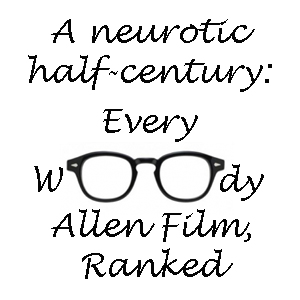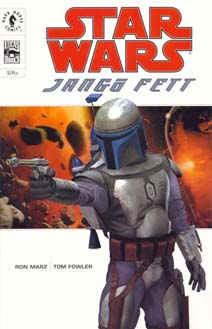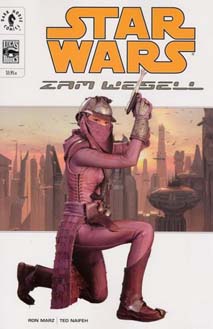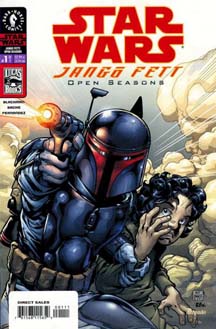As fans know, there are two continuity branches to “Star Wars” storytelling: The movies and TV shows overseen by George Lucas (and now Disney) and the Expanded Universe that was kinda-sorta overseen by Lucas (and has now been canceled by Disney). On a handful of occasions, stories from the former contradicted stories from the latter, and in many of those cases, EU writers went to work retconning (as in retroactive continuity).
One of the biggest contradictions was introduced in “Episode II: Attack of the Clones,” when Boba Fett’s backstory was re-written by Lucas, and it led to one of the most beautiful EU retcons. Daniel Keys Moran’s “The Last One Standing: The Tale of Boba Fett,” from “Tales of the Bounty Hunters” (1996), told us that Boba Fett was once known as Jaster Mereel, the journeyman protector of Concord Dawn. “Attack of the Clones” said no, Boba is actually the clone son of a man named Jango Fett.
Haden Blackman’s “Jango Fett: Open Seasons” (April-July 2002) stays true to Lucas’ vision while also incorporating Moran’s – and, for that matter, providing inspiration for “The Clone Wars’ “ clash between traditional Mandalorians and the murderous splinter group Death Watch. (In fact, the leader of Death Watch in both “Open Seasons” and “The Clone Wars” is named Vizsla — presumably they are relatives.)
“Open Seasons” is placed on the timeline right after “Episode I” – 10 years before “Episode II” – but that’s because of the framing device, where Count Dooku recruits Jango Fett as the prime clone for an army. The flashbacks take place a couple decades before that, telling Jango’s coming-of-age journey. In Issue 1, Jango’s parents are killed by Death Watch, and the youth is taken in by Jaster Mereel, leader of the Mandos, who becomes like a father to Jango. In Issue 4, Dooku and Jango hash out the cloning deal:
Dooku: “You want a son?”
Jango: “No. An apprentice. He will become Jaster’s legacy.”
So it makes sense that Boba would later use Jaster’s name as an alias, leading the “Tale of Boba Fett” narrator to believe that is indeed his identity. A masterful piece of retconning by Blackman.
I like the way each issue of “Open Seasons” chronicles a key episode in Jango’s life while also peppering in bits of Dooku’s backstory. In Issue 2, Jango climbs up the ranks of the principled mercenary Mandalorian soldiers. And in Issue 3, we learn why Jango hates the Jedi Order – he’s the lone survivor of a morally questionable Jedi raid on the Mandalorians, and he ends up as a slave on Galidraan — and why Dooku leaves the order. After the bloodbath on the snowy world, Dooku wonders “What have we done?” and later reflects: “It was a misguided mission from the start. And not the first of the Council’s many … poor decisions.”
Further enhancing “Open Seasons” is the art by Ramon Bachs (pencils), Raul Fernandez (inks) and Brad Anderson (colors). Fitting with the episodic nature of the series, each issue hits a reader with a different color palette: The golden farm world of Concord Dawn, bleak war-torn Korda, snow-strewn Galidraan, and a world of grasslands and rivers where Jango and Vizsla fight.


While “Open Seasons” expands Jango’s backstory, readers first met him earlier in 2002 – before the movie came out – in the linking one-shots “Jango Fett” (January) and “Zam Wesell” (March).
This workmanlike yarn by Ron Marz is a meatier teaser to “Episode II” than the “Episode I” teaser series “Prelude to Rebellion,” which featured Ki-Adi-Mundi. Being the father of Boba Fett, and a Mandalorian and a bounty hunter, Jango has a built-in coolness factor. Zam Wesell, not so much. But this story salvages her, hinting at an attraction between the two bounty hunters. Which is also odd, because she’s not technically a human woman – although it seems to be the form she prefers.
Jango: “You’re no lady.”
Zam: “Sometimes I am.”
In “Episode II,” there’s no good reason why Zam Wesell needs to be a shapeshifting clawdite. Whereas “X-Men” always found creative plot reasons for Mystique to shape-shift, Zam doesn’t use the ability for plot purposes in the movie and she only does so once in her one-shot comic, when she infiltrates a crime lord’s group.

In addition to being the only adult EU story about Zam Wesell (who is featured more in junior reader books), the “Zam” one-shot is also notable for portraying the noble demise of Yarael Poof, who was on the “Episode I” Jedi Council but not the “Episode II” Council (presumably because the Council fights in the Battle of Geonosis, and a long-necked Jedi would be difficult to render).
As is often the case in Dark Horse’s portrayal of Jedis, Poof has a distinct “X-men”-esque ability. Actually, two of them: He can project images — he conjures up a rancor monster to chase off some baddies – and he can absorb energy. Poof uses the latter skill to defuse a magic idol that could’ve destroyed Coruscant. This reminds me of Issue 87 of the Marvel series, where Kiro saved the entire universe from a superweapon in a similar fashion.
The “Jango Fett”/”Zam Wesell” two-parter arguably humanizes these bounty hunters a bit too much: They try to save Coruscant after realizing the danger of the idol they were paid to move there. It makes the story seem a bit kiddie-oriented. “Heroes sometimes come in the most unexpected of guises,” Mace Windu says over a final panel featuring the two not-so-bad-after-all bounty hunters. I guess it’s harmless enough since both characters are killed off in their movie debut anyway. For a richer story of a complex individual, though, “Jango Fett: Open Seasons” is the way to go.

